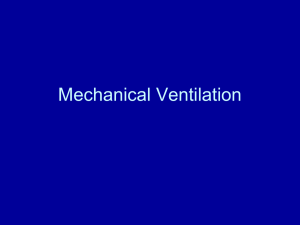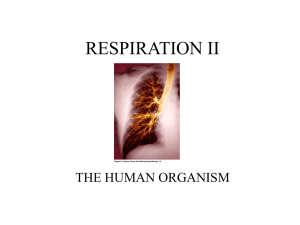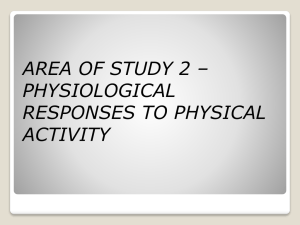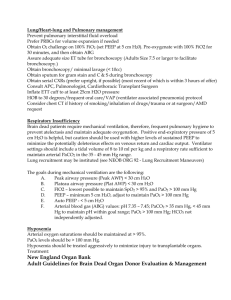adult-ventilator-cou.. - Middle East Critical Care Assembly
advertisement
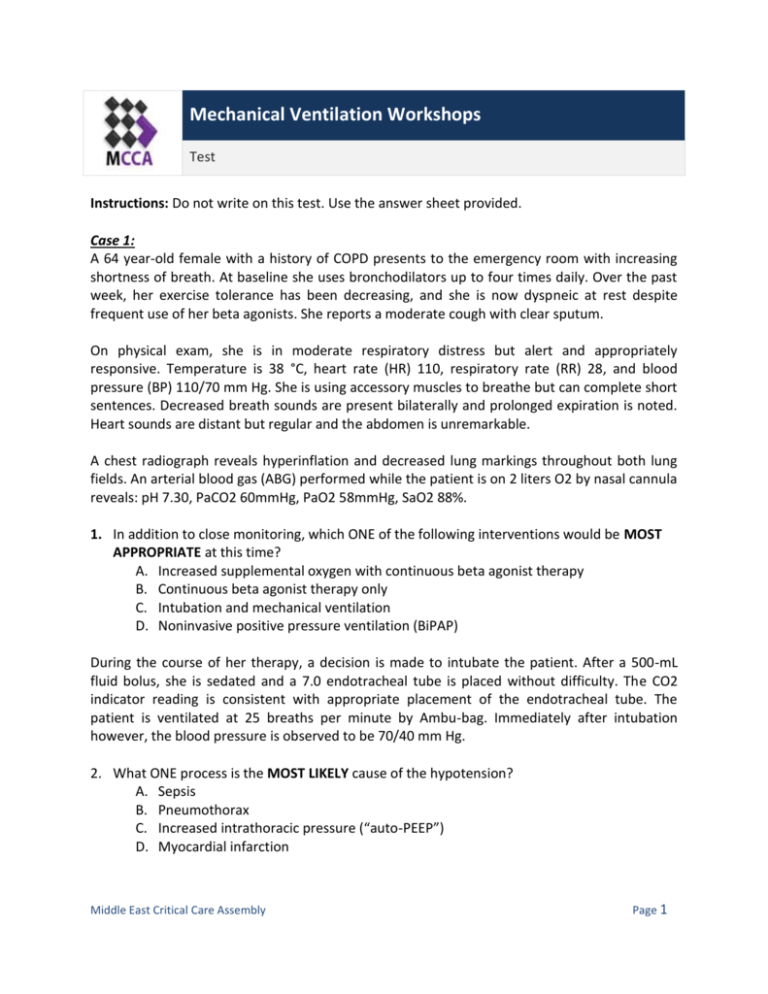
Mechanical Ventilation Workshops Test Instructions: Do not write on this test. Use the answer sheet provided. Case 1: A 64 year-old female with a history of COPD presents to the emergency room with increasing shortness of breath. At baseline she uses bronchodilators up to four times daily. Over the past week, her exercise tolerance has been decreasing, and she is now dyspneic at rest despite frequent use of her beta agonists. She reports a moderate cough with clear sputum. On physical exam, she is in moderate respiratory distress but alert and appropriately responsive. Temperature is 38 °C, heart rate (HR) 110, respiratory rate (RR) 28, and blood pressure (BP) 110/70 mm Hg. She is using accessory muscles to breathe but can complete short sentences. Decreased breath sounds are present bilaterally and prolonged expiration is noted. Heart sounds are distant but regular and the abdomen is unremarkable. A chest radiograph reveals hyperinflation and decreased lung markings throughout both lung fields. An arterial blood gas (ABG) performed while the patient is on 2 liters O2 by nasal cannula reveals: pH 7.30, PaCO2 60mmHg, PaO2 58mmHg, SaO2 88%. 1. In addition to close monitoring, which ONE of the following interventions would be MOST APPROPRIATE at this time? A. Increased supplemental oxygen with continuous beta agonist therapy B. Continuous beta agonist therapy only C. Intubation and mechanical ventilation D. Noninvasive positive pressure ventilation (BiPAP) During the course of her therapy, a decision is made to intubate the patient. After a 500-mL fluid bolus, she is sedated and a 7.0 endotracheal tube is placed without difficulty. The CO2 indicator reading is consistent with appropriate placement of the endotracheal tube. The patient is ventilated at 25 breaths per minute by Ambu-bag. Immediately after intubation however, the blood pressure is observed to be 70/40 mm Hg. 2. What ONE process is the MOST LIKELY cause of the hypotension? A. Sepsis B. Pneumothorax C. Increased intrathoracic pressure (“auto-PEEP”) D. Myocardial infarction Middle East Critical Care Assembly Page 1 3. The MOST APPROPRIATE first intervention to improve the cardiovascular compromise would be to: A. Increase IV fluids B. Place a 16-gauge needle in the left anterior second intercostal space C. Stop bagging and allow the patient to exhale D. Begin dopamine at 5 mcg/kg/minute 4. The BP improves to 95/65. Which ONE of the following ventilator settings would be MOST APPROPRIATE for this patient (60 kg)? A. Volume assist-control with respiratory rate 22, tidal volume 400mL, PEEP 5 cm H2O, FIO2 1.0 B. Volume assist-control with respiratory rate 12, tidal volume 500mL, PEEP 5 cm H2O, FIO2 0.6 C. Volume assist-control with respiratory rate 20, tidal volume 700mL, PEEP 5 cm H2O, FIO2 0.6 D. Pressure assist-control ventilation with respiratory rate 15, inspiratory pressure of 25 cm H2O, inspiratory to expiratory (I:E) ratio 1:1, PEEP 5 cm H2O, FIO2 1.0 5. In volume assist-control ventilation (not pressure regulated), if the respiratory rate is set at 16 breaths per minute and tidal volume 600 mL, what ONE statement is TRUE of the tidal volume delivered if the patient’s measured respiratory rate is 22 breaths per minute? A. 600 mL every breath B. 600 mL during the 16 set breaths and the rest determined by patient effort C. Tidal volume will be determined by patient effort each breath D. Tidal volume will vary depending on lung compliance 6. After 3 days of mechanical ventilation, the patient is awake, follows commands, and has an adequate cough reflex. She is placed on continuous positive airway pressure (CPAP) of 5 cm H2O. After one minute she has a respiratory rate of 20 and tidal volume of 300mL. Of the following options, which ONE would be the MOST APPROPRIATE plan for the day regarding mechanical ventilation? A. Sedate the patient and resume volume assist control ventilation B. Sedate the patient and begin pressure assist control ventilation C. Begin a weaning trial with pressure support ventilation or a T-piece D. Have the patient evaluated for tracheostomy Case 2 A 29-year-old (60kg) female is found unresponsive in a city park after ingesting an unknown substance. The patient is resuscitated and intubated in the field by EMS. On arrival to the ER, the patient’s temperature is 38.4◦C, HR is 110, and BP is 130/78. Thick sputum is being suctioned from the endotracheal tube. Lung exam reveals crackles in the right lower chest Middle East Critical Care Assembly Page 2 without wheezes. Heart sounds are normal, and urine output is adequate. A chest radiograph shows a dense infiltrate in the right lower lobe. The patient is placed on synchronized intermittent mandatory ventilation (SIMV) with tidal volume 450 mL, set respiratory rate 16 breaths/minute, PEEP 5 cm H2O, and FiO2 0.40. On these settings, the patient’s respiratory rate is measured at 30 breaths per minute. An arterial blood gas reveals: pH 7.45, PaCO2 34 mm Hg, PaO2 50 mm Hg, and SaO2 83%. The FiO2 is increased to 100%, and an ABG done 30 minutes later shows: pH 7.43, PaCO2 36 mm Hg, PaO2 55 mm Hg, and SaO2 89%. The patient’s measured respiratory rate is unchanged. 7. The PRIMARY physiologic abnormality accounting for the hypoxemia is: A. Excessive dead space ventilation B. Low cardiac output C. Intrapulmonary shunt D. Hypoventilation 8. Which ONE of the following is TRUE of synchronized intermittent mandatory ventilation (SIMV)? A. The tidal volume of patient triggered breaths above the set rate is determined by the set tidal volume B. The tidal volume of patient triggered breaths above the set rate is determined by patient effort C. The tidal volume of each breath is determined by patient effort D. SIMV is a form of pressure-cycled ventilation Later that night, a nurse calls you over to examine the patient because her O2 saturation has fallen over the past 5 minutes from 94 to 80% despite an increase in FiO2 to 1.0 (100% oxygen). You notice that breath sounds are audible bilaterally but decreased symmetrically, and there is no wheezing present. Peak airway pressure has increased to 65 cm H2O (from 40 cm H2O) but plateau pressure is relatively unchanged at 25 cm H2O. Measured respiratory rate is now 42, her heart rate is 110, and her BP is 150/85. 9. What ONE intervention would be MOST LIKELY to improve the physiologic process causing the patient’s hypoxemia? A. Emergent needle decompression of presumed pneumothorax B. Emergent tissue plasminogen activator (tPA) followed by heparin C. Suctioning followed by change of the endotracheal tube if no improvement D. Bronchodilators followed by IV solumedrol After you perform the proper intervention, the patient stabilizes. Gradually over the next three days her oxygenation improves. The patient is changed to pressure support ventilation with inspiratory pressure of 20 cm H20 and PEEP of 5 cm H20. Middle East Critical Care Assembly Page 3 10. Which ONE of the following is TRUE regarding the patient’s respiratory status on pressure support ventilation (PSV)? A. Tidal volumes will be the same with each breath B. Minute ventilation will be constant C. Minute ventilation will vary according to her strength and effort D. Inspiratory to expiratory (I:E) ratio is set by the physician Case 3 A 56 year-old female with diabetes mellitus is brought to the emergency room with a 3-day history of dysuria and low back pain. In the emergency room, she is obtunded and tachypneic. Her temperature is 38.9◦C, RR 32, HR 120, BP is 80/50, and her ideal weight is 60 kg. The patient has dry mucous membranes and brisk capillary refill. Faint bilateral inspiratory crackles are heard on lung exam, and the cardiac exam is significant only for tachycardia. Abdominal exam is unremarkable. No pedal edema is seen. The white blood cell count is 13,000 per mL and urinalysis reveals >100,000 WBCs with many bacteria. A chest radiograph demonstrates bilateral interstitial infiltrates without effusions. An ABG taken while the patient is breathing 100% oxygen by facemask reveals a pH of 7.30, PaCO2 25 mm Hg, PaO2 62 mm Hg, and SaO2 90%. As IV fluids and antibiotics are begun, it is felt that ventilatory support is indicated. 11. Which ONE of the following would be the MOST APPROPRIATE form of ventilatory support at this time? A. Noninvasive positive pressure ventilation (BiPAP) by face mask B. Intubation and volume assist-control ventilation, respiratory rate 20, tidal volume 360 mL C. Intubation and intermittent mandatory ventilation, respiratory rate 20, tidal volume 600 mL D. Intubation and volume assist-control ventilation, respiratory rate 20, tidal volume 500 mL The patient was placed on a volume assist-control mode of ventilation. Blood pressure is 100/70 and HR is 90. While sedated, her peak airway pressures are 32 cm H2O and plateau pressures are 24 cm H2O. On a FiO2 of 0.60 and PEEP of 5.0, an ABG reveals a pH 7.28, PaCO2 36 mm Hg, PaO2 of 55 mm Hg, and SaO2 85%. 12. Which ONE of the following would be the MOST APPROPRIATE next measure? A. Increase the FiO2 to 0.80 B. Increase the tidal volume by 100 mL from your initial setting C. Increase the rate by 4 breaths per minute from your initial setting D. Increase the PEEP to 10 cm H2O 13. Which ONE of the following interventions would PROLONG the expiratory phase (“E time”) of a patient receiving volume assist-control mechanical ventilation (volume cycled mode)? Middle East Critical Care Assembly Page 4 A. B. C. D. Increase respiratory rate Increase inspiratory flow rate Increase PEEP Increase tidal volume Several days later in the patient’s course, she was being managed on pressure assist-control ventilation with a respiratory rate of 18, a PEEP of 12 cm H2O, and total inspiratory pressure 30 cm H2O. The inspiratory to expiratory (I:E) ratio is 1:1. Initially on these settings, measured tidal volumes averaged 400 mL. Two days later on the same settings, the measured tidal volumes now average 500 mL. 14. Which ONE of the following is the MOST LIKELY explanation for the change in tidal volume? A. Increased respiratory effort by the patient. B. Increased lung compliance C. Increased dead space ventilation D. Air trapping leading to increased intrinsic PEEP (“auto-PEEP”) On Hospital Day 14, the patient is afebrile, hemodynamically stable, and has a central venous pressure (CVP) of 12. She has been managed with volume assist-control ventilation for the past 7 days and currently is receiving a tidal volume of 360 mL, respiratory rate of 24 breaths per minute, PEEP of 15 cm H2O, and FiO2 0.5. An ABG at this time reveals: pH 7.35, PaCO2 50 mm Hg, PaO2 90 mm Hg, and SaO2 97%. Serum HCO3 is 27 mEq/L. Peak pressure is 48 cm H2O and plateau pressure is 38 cm H2O. 15. Which ONE of the following would be the MOST APPROPRIATE intervention at this time? A. Decrease PEEP B. Begin an infusion of NaHCO3 C. Increase tidal volume D. Give IV furosemide On hospital Day 21, a tracheostomy is performed at the bedside without complication. That night, after being turned during a bath, the peak pressure alarms on the ventilator are heard and a decreased SaO2 is noted on the monitor. On exam, the patient is in respiratory distress and is tachycardic. The tracheostomy tube appears dislodged from its original position. Lung exam reveals limited breath sounds bilaterally without wheezes. The patients’ neck appears swollen, and the skin of the neck and upper chest is crepitant to touch. 16. Which ONE of the following is the MOST APPROPRIATE immediate intervention? A. Call for a stat portable chest radiograph B. Place bilateral chest tubes C. Attempt to replace the tracheostomy tube D. Remove the tracheostomy tube and place an oral endotracheal tube Middle East Critical Care Assembly Page 5 Case 4 A 35-year-old female (60 kg) with asthma is intubated on arrival to the ER for respiratory distress. The ventilator mode is volume assist-control; settings are FiO2 0.6 (60% oxygen), tidal volume 500 mL, PEEP 5 cm H2O, set respiratory rate of 22 breaths/minute, inspiratory flow of 80 L/min. The patient is heavily sedated and not breathing over the set rate. Fifteen minutes after intubation, an ABG shows: pH 7.22, PaCO2 60 mm Hg, PaO2 85 mm Hg, and SaO2 95%. Peak inspiratory pressure is 70 cm H2O and plateau pressure is 40 cm H2O. Her blood pressure is 85/60 and decreasing. The heart rate has increased to 120 (from 95 earlier). 17. What SINGLE intervention would be MOST APPROPRIATE right now? A. Decrease respiratory rate to 12 breaths per minute B. Increase PEEP to 15 cm H2O C. Increase tidal volume to 600 mL D. Decrease FiO2 to 0.3 (30%) 18. How would you quantify the amount of “auto-PEEP” present in a patient (who is sedated and paralyzed)? A. Measure airway pressure during a 1.0-second pause at the end of inspiration (and subtract set PEEP) B. Measure airway pressure during a 1.0-second pause at the end of expiration (and subtract set PEEP) C. Subtract the plateau pressure from the peak inspiratory pressure D. Multiply flow rate times the tidal volume On the morning of the second day of mechanical ventilation while heavily sedated, the patient’s SaO2 decreases suddenly from 96 to 84% and her BP falls from 118/76 to 90/55. Peak airway pressure has increased from 40 cm H2O to 55 cm H2O and the plateau pressure has increased from 28 cm H2O to 50 cm H2O. The patient remains sedated. On lung exam wheezes are present. Good air movement is present on the left side, although somewhat decreased air movement is noted on the right. Heart sounds are distant and regular. 19. Which ONE of the following is the MOST LIKELY explanation for this change in airway pressures? A. Occlusion of the endotracheal tube B. Increased bronchospasm C. Patient-ventilator asynchrony D. Tension pneumothorax 20. The breath indicated by the letter A is: Middle East Critical Care Assembly Page 6 A. B. C. D. Spontaneous breath Assisted breath (synchronized) Controlled breath Supported breath 21. Which of the following best describe the below mechanical ventilation mode? A. Pressure assist control ventilation (PACV) B. Volume assist control ventilation (VACV) Middle East Critical Care Assembly Page 7 C. Pressure support ventilation (PSV) D. Pressure targeted synchronized intermittent ventilation (SIMV) E. Continuous positive airway pressure (CPAP) 22. Which of the following best describe the below mechanical ventilation mode? A. B. C. D. E. Pressure assist control ventilation (PACV) Volume assist control ventilation (VACV) Pressure support ventilation (PSV) Pressure targeted synchronized intermittent ventilation (SIMV) Continuous positive airway pressure (CPAP) 23. A 14-year-old women with status asthmaticus has been sedated and placed on mechanical ventilation in the volume control mode with initial tidal volume of 6 mL/kg, rate 24, PEEP 0 cm H2O and FiO2 0.4. Her blood gas measurements are PO2 78 mm Hg, PCO2 38 mmHg, and pH 7.46. Her ventilator graphics are shown in the next slide Middle East Critical Care Assembly Page 8 A. B. C. D. E. Increase the tidal volume Increase the inspiratory time Change to pressure assist-control ventilation with same tidal volume and settings Decrease the inspiratory rate Add positive end-expiratory pressure 24. . Which set of the following graphics is most consistent with pulmonary edema: Middle East Critical Care Assembly Page 9 A. B. C. D. E. 25. A 10 year-old man who underwent exploratory laporatomy and was placed on volume controlled mode post-operatively with a tidal volume 230, PEEP of 3, FiO2 of 60% and a rate of 24. The respiratory therapist has made a change on the ventilator that changed the graphics as shown in below: Middle East Critical Care Assembly Page 10 A. B. C. D. Changed to synchronized intermittent mandatory ventilation (SIM) Changed to pressure support ventilation (PSV) Switched on auto flow Changed to pressure controlled mode Middle East Critical Care Assembly Page 11 Mechanical Ventilation Workshops Test Name ID Number Please circle around the right answer! 1 2 3 4 5 6 7 8 9 10 11 12 13 14 15 16 17 18 19 20 21 22 23 24 25 A A A A A A A A A A A A A A A A A A A A A A A A A Middle East Critical Care Assembly B B B B B B B B B B B B B B B B B B B B B B B B B C C C C C C C C C C C C C C C C C C C C C C C C C D D D D D D D D D D D D D D D D D D D D D D D D D E E E E E E E E E E E E E E E E E E E E E E E E E Page 12 Answers 1) D 2) C 3) C 4) B 5) A 6) C 7) C 8) B 9) C 10) C 11) B 12) D 13) B 14) B 15) A 16) D 17) A 18) B 19) D 20) B 21) C 22) A 23) D 24) C 25) C Middle East Critical Care Assembly Page 13


